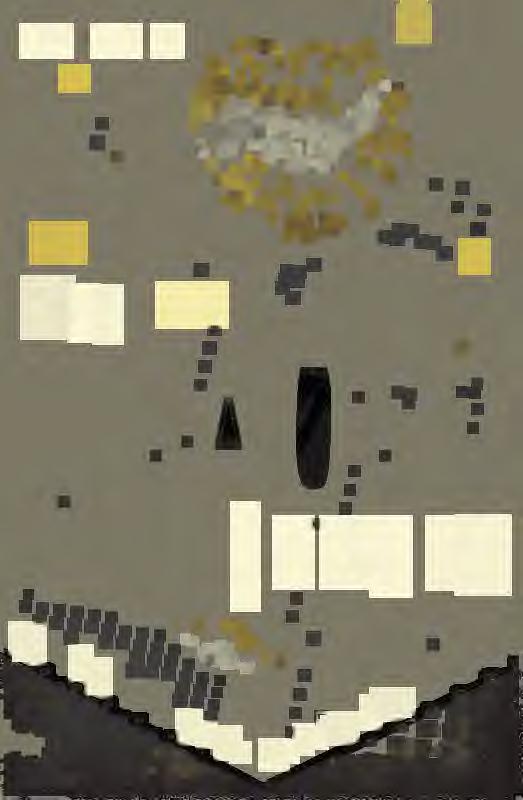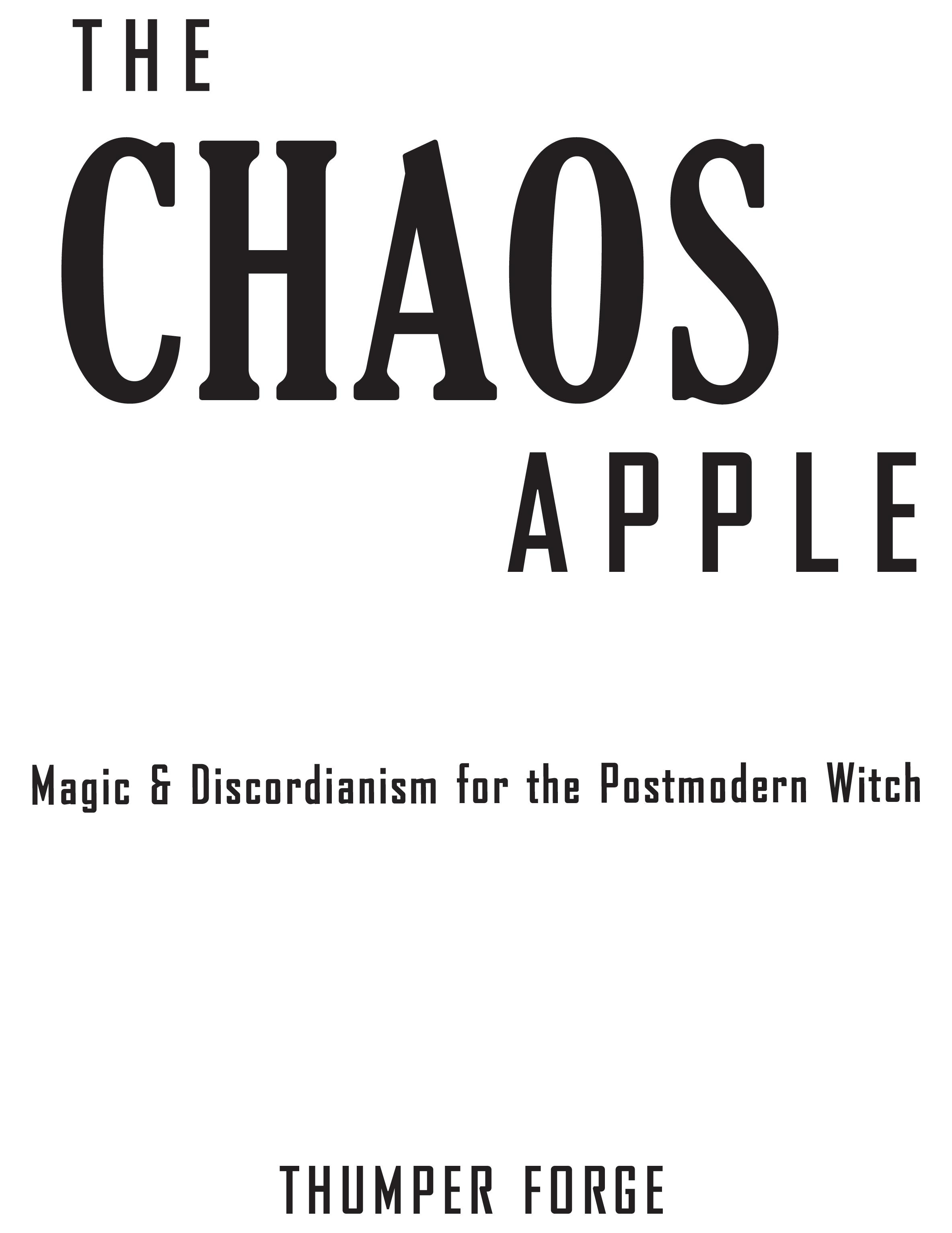
Praise for The Chaos Apple
“A brilliantly irreverent crash course in making magic strange again. Thumper Forge brings the prankster spirit of Eris to life with sharp insight, grounded technique, and a clear understanding of Chaos Magic, Discordianism, and Witchcraft.”
—Mat Auryn, author of Psychic Witch, Mastering Magick, and The Psychic Art of Tarot
“A wonderful mix of occult insight, humor, and practical magic that is both accessible and in depth. It is an antidote to much of the confusion found online concerning Chaos Magic and Discordianism.”
—Laura Tempest Zakroff, author of Weave the Liminal and Sigil Witchery
“The most succinct book about Discordianism since Malaclypse the Younger and Omar Khayyam Ravenhurst unleashed the Principia Discordia onto the world over fifty years ago.”
—Jaq D Hawkins, author of The Chaonomicon and Chaos Witch
“This book is accessible in tone and content …. From the dance breaks, practices, research, mythology, and stories, I felt welcomed, confronted, and delighted by Thumper.”
—Irisanya Moon, author of Pantheon: The Greeks and Hestia: Goddess of Hearth, Home & Community
“A dynamic fusion of Chaos Magic, Witchcraft, and Discordianism that enriches each tradition rather than diluting them to neatly fit together. This isn’t just a blend; it’s a true synergy.”
—Tommie Kelly, creator of AdventuresInWooWoo.com and The Forty Servants oracle deck
“A quantum leap into a world where belief is your playground and laughter is your most potent weapon …. Forge will teach you to craft sigils, embrace the glorious chaos, dance on the edge of the possible, and discover that the most profound magic is often found in the heart of your good, cosmic belly laugh.”
—Elhoim Leafar, author of Manifestation Magic and Dream Witchery
“An accessible and patient introduction for the new Chaote, while also demonstrating a depth of knowledge of Discordianism that offers insights for even the most seasoned of Eris’s disciples.”
—Brenton Clutterbuck, author of Chasing Eris
“Forge paradoxically makes sense of chaos. The book is intelligent, thoughtful, easy to understand, and often laugh-out-loud funny.”
—Deborah Lipp, author of Bending the Binary
“Forge has done the most delightfully heretical thing: They have created cogency, narrative, and clarity for practicing Chaos Witches and those willing to sample its catma.”
—Diana Rajchel, author of Urban Magick and Hex Twisting
“Much like the magic it teaches, The Chaos Apple somehow manages to be both whimsical and practical. This book is a dazzling—and yes, chaotic—waltz through the history and practice of Chaos Magic and Discordianism.”
—Jack Chanek, author of Tarot for the Magically Inclined
“The publication of The Chaos Apple is a moment within Chaos Witchcraft that has the potential to move the practice from the emerging or fringe of modern occult into the mainstream.”
—Waspie Joanne Fitzpatrick, author of Chaos Covens and Chaos
Witchcraft in Practice
“Thumper has provided a vivid and engaging overview on not only some of the main figures, ideas, and approaches, but also the primary insight that it requires ritual action in order to have lasting spiritual value.”
—Steve Dee, author of The Heretic’s Journey and Chaos Monk
“Illuminating, innovative, and deliciously Discordian, The Chaos Apple is packed with novel insights and magical practices that yield tangible results in the real world.”
—Soror Velchanes, author of The Planetary Magic Workbook
“A delicious Discordian deep dive into the cauldron of Chaos Witchcraft. Expect occult and mythic histories, meditations on the dance between chaos and order, practical techniques to enhance your own sorcery and more.”
—Julian Vayne, coauthor of Chaos Craft and The Book of Baphomet author of The Chaonomicon and Chaos Witch
“A whimsical guide to Chaos Witchcraft. Within its pages, you will discover how to conjure the inherent humor of the universe. Don’t miss this wild ride through the multiverse!”
—Sven Davisson, author of Breeding Devils in Chaos
“A delightfully Discordian tome, weaving magic and witchcraft with a healthy helping of dance breaks, and no matter your path, you’re sure to get something out of it.”
—Moss Matthey, author of An Apostate’s Guide to Witchcraft

© B. Wycoff

About the Author

Thumper Forge (Houston, TX) is a Gardnerian High Priest, an initiate of the Minoan Brotherhood, an Episkopos of the Dorothy Clutterbuck Memorial Cabal of Laverna Discordia, and a notary public. He also blogs for Patheos Pagan. Learn more at ThumperForge.com.


The Chaos Apple: Magic & Discordianism for the Postmodern Witch Copyright © 2025 by Thumper Forge. All rights reserved. No part of this book may be used or reproduced in any manner whatsoever, including internet usage, without written permission from Llewellyn Worldwide Ltd., except in the case of brief quotations embodied in critical articles and reviews. No part of this book may be used or reproduced in any manner for the purpose of training artificial intelligence technologies or systems.
First Edition
First Printing, 2025
Book design by Rordan Brasington
Cover design by Kevin R. Brown
Interior illustrations by Llewellyn Art Department: x, 83, 86, 212
Interior illustrations provided by the author: 58, 97, 103, 163
Photography is used for illustrative purposes only. The persons depicted may not endorse or represent the book’s subject.
Llewellyn Publications is a registered trademark of Llewellyn Worldwide Ltd.
Library of Congress Cataloging-in-Publication Data
Names: Forge, Thumper author
Title: The chaos apple : magic & discordianism for the postmodern witch / Thumper Forge.
Description: First edition. | Woodbury, Minnesota : Llewellyn, [2025] | Includes bibliographical references.
Identifiers: LCCN 2025027393 (print) | LCCN 2025027394 (ebook) | ISBN 9780738775432 paperback | ISBN 9780738775524 ebook
Subjects: LCSH: Witchcraft | Magic
Classification: LCC BF1566 .F668 2025 (print) | LCC BF1566 (ebook)
LC record available at https://lccn.loc.gov/2025027393
LC ebook record available at https://lccn.loc.gov/2025027394
Llewellyn Worldwide Ltd. does not participate in, endorse, or have any authority or responsibility concerning private business transactions between our authors and the public.
All mail addressed to the author is forwarded but the publisher cannot, unless specifically instructed by the author, give out an address or phone number.
Any internet references contained in this work are current at publication time, but the publisher cannot guarantee that a specific location will continue to be maintained. Please refer to the publisher’s website for links to authors’ websites and other sources.
Llewellyn Publications
A Division of Llewellyn Worldwide Ltd.
2143 Wooddale Drive Woodbury, MN 55125-2989 www.llewellyn.com
Printed in the United States of America
GPSR Representation:
UPI-2M PLUS d.o.o., Meduli eva 20, 10000 Zagreb, Croatia matt.parsons@upi2mbooks.hr
Other Books by Thumper Forge
Disclaimer
The author and publisher of The Chaos Apple assume no liability for any injuries or damages caused by the reader’s use of content contained in this publication, and common sense is strongly recommended when approaching all practices described herein. The material in this book is not intended as a substitute for professional medical or psychological advice. Shadow work is not a replacement for therapy. Eris is not a therapist. If you are having a rough go of things, please talk to a trained counselor, okay? They won’t judge you, and neither will we.
The reader is strongly advised to consult their personal healthcare providers regarding treatment of any preexisting medical or psychological conditions. We don’t know if that mole looks weird. Go ask your doctor. Additionally, the reader is advised to conduct thorough research on any plant, herb, essential oil, incense, overthe-counter pain reliever, comic book character, ancient Greek personification, or carbonated beverage mentioned in this text before actively attempting to incorporate said substance or spirit into one’s physical practice. Always take precautions when working with fire, and never leave candles, charcoal, lit matches, or anything burning unattended. Fire is codependent and will act out if it feels neglected. I read that in a book.



Contents
Crafting with Chaos … xiv
Discordian Dance Breaks … xv
Foreword by Michael Thomas Ford … xvii
Introduction … 1
Chapter 1: The Chaos Witch Goes Viral … 9
Chapter 2: Origins, Elements, and Eris … 21
Chapter 3: Chaos Explained and Goddesses Snubbed … 33
Chapter 4: Discordian Seasons and Apostles of Eris 47
Chapter 5: Principles of Chaos Witchcraft … 63
Chapter 6: The Chaos Star and Discordian Diamond … 79
Chapter 7: Sigils, Servitors, and Symbols 95
Chapter 8: Daemons, Demons, and Pop Culture Chaos … 115
Chapter 9: Ethical Chaos and the Curse of Greyface … 133
Chapter 10: Chaos Spirituality 153
Chapter 11: Chaos Divination … 171
Chapter 12: Holydays and Astrology … 189
Chapter 13: A Miscellany of Misadventures … 209
Conclusion … 225
Chaos Continued … 231
Bibliography … 235
A Simple Paradigm Shift … 18
Hail, Squat … 30
Rolling for Ism … 44
The Five-Sided Circle … 59
Anointings Anonymous 76
Customizing Your Colors … 93 Moon Water … 110
Cutting Cords 128
The Pringles® Can Curse … 150 A Step in the Right Direction … 167
Spreading the Love 186
Unverified Personal Tib … 206
Crafting with Chaos
Foreword
In June of 2012, Slate contributor Dahlia Lithwick published a piece titled “Chaos Theory: A Unifying Theory of Muppet Types” in which she posited that each of us can be classified as an Order Muppet or a Chaos Muppet. The basis for this is, of course, the characters from Sesame Street and The Muppet Show.
Broadly speaking, Order Muppets are the ones who attempt to control the chaos around them. The stoic Sam the Eagle and perennial show wrangler Kermit the Frog are the best examples. Chaos Muppets, on the other hand, embrace or even create their namesake state. See Cookie Monster and Animal.
Even as a kid, decades before Lithwick coined a term for them, I knew I was an Order Muppet. As an avid viewer of both shows, I knew I was Bert, perpetually annoyed by Ernie’s carefree approach to everything, regardless of consequences. I was Kermit, always trying to get people to follow the rules, as I did. I understood these characters on a fundamental level.
But the characters I loved were all pure Chaos: Cookie Monster, Grover, Ernie. I was fascinated by them, even if I couldn’t let myself behave like them.
Their willingness to just let things happen instead of following a plan was disquieting for reasons I couldn’t explain. It was also deeply enticing in a way that made me excited but anxious.
I have a strong memory of baking chocolate chip cookies by myself for the first time and measuring out every single ingredient precisely as laid out in Betty Crocker’s New Boys and Girls Cookbook. And when those cookies did not come out of the oven looking or tasting as I thought they would, I was absolutely confounded.
“But I followed the recipe!” I wailed.
“It’s not all about the recipe,” my grandmother informed me. “All kinds of things can go wrong with baking. That’s just how it is.”
This was not the reassuring message she thought it was. It was deeply upsetting to ten-year-old me. What was the point of having recipes if they didn’t turn out perfectly every time?
Later, I would ask myself the same question about the Christian faith in which I was raised. For years, I’d been told that if I followed a set of rules exactly, I would be happy. If I didn’t follow them, or tried to bend or break them, I would be unhappy. Worse, upon my death, I would experience unending torment.
Eventually, I realized that the people telling me what rules to follow were themselves not following them. Or even if they were, they didn’t seem particularly happy. Something, I concluded, was wrong with the methodology.
You would think that once I discovered the world of magic, I wouldn’t apply the same way of thinking to it. But old habits die hard, and for a long time I sought out a path that would explain things clearly and provide ways of working magic that guaranteed results.
I was at least experienced enough to understand that it wasn’t all just about saying the right words, making the right gestures, or using the right ingredients. Still, I thought there should be an
approach that worked reliably if I applied its rules. Again, I was disappointed to discover that attempting to impose order on magic didn’t work. At least, not for me.
Enter, Chaos.
A few years ago, I reached a point where I was worn out by the magical world. At the same time, I became very interested in the concept of trying to work with the genius loci of the place in which I live. As part of this work, I crafted a clay figure of how I see the spirit of this place and placed it on the table I use for magical stuff. Not long after, I found myself wanting to add another figure to it, a carved wooden representation of the Slavic god Veles. Over time, I added more figures. A ceramic statue of commedia dell’arte character Punch and the Norse god Freyr. A figurine based on Swedish illustrator John Bauer’s depictions of trolls and a little plastic Papa Smurf. A chipped alabaster smoking fisherman my husband found at a flea market and brought home saying, “I don’t know why, but I think he belongs with your other statues.”
And he did.
I call these figures the Council. At first glance, they have nothing in common. They come from different pantheons, or no pantheons at all. In some cases, they represent ostensibly opposing forces. Anyone looking at them on the table would likely assume they’re simply a collection of figurines, perhaps placed there randomly while awaiting dusting.
To me, what they are is a visual representation of Chaos Witchcraft—seemingly disparate forces working together to achieve results. How they do this, and how I work with them, could be a whole book itself. But this is Thumper’s book, so I want to talk about them now.
I have known Thumper for more than fifteen years, before they were Thumper (although they were always Thumper; they just
needed someone to point it out), before they were writing about Chaos Witchcraft (although they were always a Chaos Witch; they just needed someone to point it out). They have always been a Chaos Muppet, bouncing from idea to idea, plan to plan, seemingly without any real direction. And yet, there has always been a direction, even when it wasn’t obvious, and that direction has been bringing them inexorably to the writing of this book.
I will let them speak for themself, because they’re good at it and don’t need my help. What I will say is that like all the strongest magical workings, this one is manifesting at exactly the right time. As I write this, in the first months of 2025, the world appears to be on fire. The news seems to be nothing but dire. All around us, things look to be out of control.
This is Chaos Witchcraft at work on a massive scale. It’s the universe being tumbled and spun around at a dizzying pace because it’s out of balance. And this is disorienting for many people, particularly those who wish things worked in an orderly, predictable fashion. As we see daily, a whole lot of us are searching for ways to stop what’s happening, to reverse it, to bring everything back into balance.
Well.
I suggest that Chaos is exactly what we need right now, that in fact everything has led to this point. And learning to work with Chaos, and with its attendant magic, is what is going to lead to the transformation we need on both the personal and the global levels.
Not that Chaos is relevant only in times of turmoil. The world will not always be on fire. But Chaos will always be relevant, and knowing how to work with it can lead to all kinds of adventures, not to mention results. It’s very easy to dismiss the concept of Chaos Witchcraft as something ridiculous, invented as a way of saying, “Nothing matters!” Rather, it’s a way of acknowledging
that, often, the way to achieve what needs to be achieved is to let go of trying to control it.
If you’re an Order Muppet like I am, this may be a frightening proposition. And even if you’re a Chaos Muppet who revels in disorder and in breaking the system just for the fun of it, you likely have a lot to learn about what Chaos actually is and how to work with it effectively.
Now go on. Get to reading. There’s a lot to talk about.
—Michael Thomas Ford
Author of The Path of the Green Man and (as Isobel Bird) the Circle of Three series
Introduction

So there I was, lying naked on a massage table, wearing LED goggles that pulsed rhythmic patterns of light into my eyes. Vaguely Middle Eastern trance music laced with monaural beats pumped in the background as I concentrated on visualizing and charging a psychic sigil, while my buddy Chester performed biofield tuning work around me and led me through controlled breathing exercises.
“Tell me again what we’re doing?” I asked.
“Chaos Magic,” Chester replied.
At that point in my life, I was dimly aware of the existence of Chaos Magic, but I knew very little about it—I assumed it was something in which cyberpunk goths dabbled during their off hours. Chester is, as he puts it, into the woo, but his practices lean more toward energy healing and goal manifestation, so I was surprised to find him throwing himself into something I associated with dark alleyways and dystopian futures.
My own background is rooted firmly in initiatory Wicca. I’m an initiate of the Gardnerian tradition of witchcraft, as well as the Minoan Brotherhood, an offshoot of British Traditional Wicca for men who love
men. And while I’ve explored many other paths in the years since my initiations, Chaos Magic never quite made it onto my radar. But the technomantic ritual Chester put me through led to unexpectedly good results, and my interest was piqued.
Chester loaned me a handful of books—Liber Null and Psychonaut by Peter J. Carrol, Condensed Chaos by Phil Hine, The Book of Results by Ray Sherwin—and I dove right in. And the first thing I learned was that Chaos Magic is not a tradition, in the sense I was used to. Rather, it’s an experimental approach to magical practice, with an emphasis on getting results. Practitioners of Chaos Magic are not tied down to any one way of doing things. Instead, they are trying different methods and techniques to find out what works for them, then trying them again to see if they can achieve consistent outcomes. And they are streamlining their practices, cutting out anything extraneous to create the most efficient route from Magical Working A to Verifiable Result B.
The Cinnamon Must Flow
To get a better idea of how Chaos Magical Theory operates, let’s apply it to a popular occult practice and see what happens.
Somewhere around 2021, it became trendy on social media for Witches to manifest prosperity by blowing cinnamon into their homes through their front doors on the first of every month. People took this practice very seriously, and there were a plethora of Instagram reels and TikTok posts demonstrating how to properly engage in the procedure.
The typical approach to this spell would be to accept it as-is and follow the directions step-by-step, and there is nothing wrong with doing so. However, if you were to approach this working from a Chaos Magic perspective, you would want to identify a
few key factors: the components, the necessary components, the limitations, and the workarounds. With all that information on hand, you would then want to determine if the procedure can be streamlined or made more efficient. Let’s start with the components: cinnamon, the first day of a month, a doorway, breath.
In the original working, there’s nothing saying that the cinnamon has to be powdered, so a cinnamon stick could conceivably be used, especially since cinnamon can be harmful to pets—a stick of cinnamon can be easily retrieved and put away before Spot or Fluffy has the chance to ingest it. But it’s that last component we don’t want to overlook: We’re blowing cinnamon across a threshold, and breathing life into something is very much a magical act. If you’re going to use an entire cinnamon stick, blow on it first, then yeet it through the front door.
Another alternative would be to add powdered cinnamon to a mug, pour hot coffee or tea over it, and blow the steam through your front door, which would also cover all the essentials of the spell. Either way, within the Chaos Magic current, we’re not just randomly skipping steps because we don’t feel like doing them. Instead, we’re differentiating between what is and is not necessary to perform a given spell, and we’re focusing on those necessities, figuring out how to maneuver around obstacles to get the results we’re looking for.
Eris in the Machine
In researching Chaos Magic, I learned that some of its pioneers had been heavily influenced by Discordianism—the modern worship of Eris, Greek goddess of Discord—which delighted me to no end. I’d been a closet Discordian for close to two decades, not quite secretly venerating Eris in my own way, without direction. But as
I slid further into Chaos Magic, bumbling into online forums and thumbing through obscure, limited-run texts, I came across more and more references to Discordianism, and more and more practitioners who, if not in active relationship with Eris, definitely held her in high regard. And I also started interacting with people who referred to themselves as Chaos Witches, even if they didn’t seem entirely sure what that meant.
At some point, it occurred to me that I should maybe write a book about that.
And this is where things got weird.
I kept telling myself I’d get around to writing a book, but I also kept putting it off. And every time I set the idea aside, something odd would happen, with the oddities increasing in intensity the longer I procrastinated. It was almost as if some discordant, supernatural force was attempting to get my attention, I mused.
And with that thought, my blog stopped working.
I’d been writing at Patheos Pagan for a little over a year at that point. Whenever a Patheos author publishes an essay, the post goes into a queue to be automatically added to their channel’s Facebook page in regularly scheduled two-hour intervals. These posts are displayed with a cover photo and title, but for some reason, when I would attempt to upload anything, the post would appear on Facebook as an unmarked link to Patheos dot com, with no image or description. Clicking on the link would lead to the actual post, but there was nothing visual to encourage readers to click the link in the first place.
Concerned, I contacted Patheos and asked, “Help?” To which they replied, “Huh. That’s odd. We’ll take care of it right now.”
And then it happened to my next post, and the two posts after that, until I was bombarding Patheos with emails asking, “Why
is this happening to me?” And they were writing back, “We don’t know, and it’s freaking us out.”
Eventually, Patheos’s IT department discovered an incompatibility between Facebook and the auto-scheduling software, which created a glitch that, somehow, only affected my blog. And because it was only causing problems for me, I suddenly realized what needed to be done to rectify the technical issues.
I sat down that evening and banged out a book proposal to Llewellyn. Immediately afterward, I added a new post to my blog, and two hours after I hit “publish,” it turned up on the Patheos Pagan Facebook page, cover photo and title displayed faultlessly.
“Point taken,” I said, in the general direction of Eris.
She didn’t respond, at least not out loud. But my blog has worked right ever since, and I’m currently writing the introduction to a book on Chaos Witchcraft, so if anything, I am very glad I finally caught the hint.
What to Expect from This Book
On the following pages, you’ll find information on the history and practice of Chaos Magic from a witchcraft perspective, along with personal experiences and recommendations. What you won’t find is the correct way to practice any of the previous magic, because honestly, there’s not one—there’s just what’s worked for me, which will hopefully give you the impetus to find out what works for you. Treat this book as a sounding board that opens roads: Borrow what works and leave the rest.
And as you read, you’ll also be taking a deep dive into Discordianism, since that religion had such an impact on the development of Chaos Magic, primarily because Discordians firmly believe in not firmly believing in anything. In her own work on the subject,
occultist Waspie Joanne Fitzpatrick submits that Chaos Witchcraft might be more accurately called Discordian Witchcraft, and I wholeheartedly agree.1 However, she also points out that the term Chaos Witchcraft has already entered the lexicon, and that rechristening it would involve more effort than it’s worth. Ergo, we’re going to go ahead and roll with Chaos Witchcraft as well, but the Discordian mindset of no-belief will allow you to explore other spiritual systems at will. And by taking cues from the Discordian worldview, you’ll be striding toward mastery of the core technique of Chaos Witchcraft, which is …
Belief as a Tool
In the eighth episode of the Netflix original series KAOS, Zeus confronts the Fates—Clotho, Lachesis, and Atropos—to avert a prophecy. The Fates are unsurprisingly not surprised to see Zeus, and they take a moment to explain the reality of the situation to him.
“For your prophecy to come to pass, you must bring it into being,” says Lachesis.
“If you decide it doesn’t exist, then it doesn’t exist,” says Atropos, to which Lachesis adds the mic drop: “The possibility exists, but without your belief, it cannot come to pass.”
In other words, Zeus can let his prophecy have power over him, or he can alter his beliefs and have power over his prophecy. And so can you.
The concept of paradigm shifting, or using belief as a magical tool, is probably the most unmistakable hallmark of Chaos Magic, which, naturally, means it’s also the most misinterpreted. A lot of people take belief as a tool to mean, “I can believe whatever I want.” Well, okay, yes, that’s true. But there’s a big difference
1. Fitzpatrick, Chaos Covens and Chaos Witchcraft in Practice.
between just saying, “I can believe whatever I want,” and actively adopting or shuffling through beliefs to accomplish your magical goals.
In Chaos Magical Theory, it’s understood that a belief is a subjective truth, and that structural belief systems have power trapped within them. If we can deconstruct or alter our own beliefs, we can release some of that power and use it to fuel our magic. This is reinforced by the Discordian concept of the catma. Whereas a dogma is couched in unquestionable truth, a catma is a transient truth: It remains unquestionable until such time as the believer chooses to question, rework, or discard it.2
Now, when it comes to structural belief systems, it’s almost instinctive to look solely at the religions that are prevalent in existing cultures—Hinduism, Heathenism, Satanism, Christianity, Buddhism, and so on. And we will be talking about those religions and what we might unlock from them. But we can also remodel the beliefs we already have to be in line with whatever work we’re trying to accomplish. Or, for lack of a better way of saying it, we can believe things that haven’t been believed yet.
There’s a wonderful epic novel by China Miéville called Kraken that perfectly exemplifies the use of belief as a tool. In this story, the preserved body of a giant squid gets stolen from the British Museum of Natural History, which, in turn, thrusts an unassuming docent named Billy Harrow into a war between various doomsday cults taking place in the underworld of London. The cults employ magic in a variety of ways to further their agendas, and over time, Billy starts to pick up on how magic works—specifically, the magic of metaphors.3
2. Higgs, The KLF, 31.
3. Miéville, Kraken.
At one point, while looking for people who can provide him with the whereabouts of the squid, Billy finds a key that had accidentally been paved into the asphalt of a city street. He also comes across a lightbulb that a restaurant employee had stored on top of a frying pan.
The next time Billy meets up with an informant, he’s ready to make a deal:
“I can pay you. Put this in the right hands, this’ll unlock the road.” He held out the key. He held up the bulb. “And I don’t know what’s incubating in this, but someone might hatch it.”4
The lesson here is that there’s magic incubating everywhere, even (or especially) in seemingly mundane places.
As a Chaos Witch, all you have to do is hatch it.



